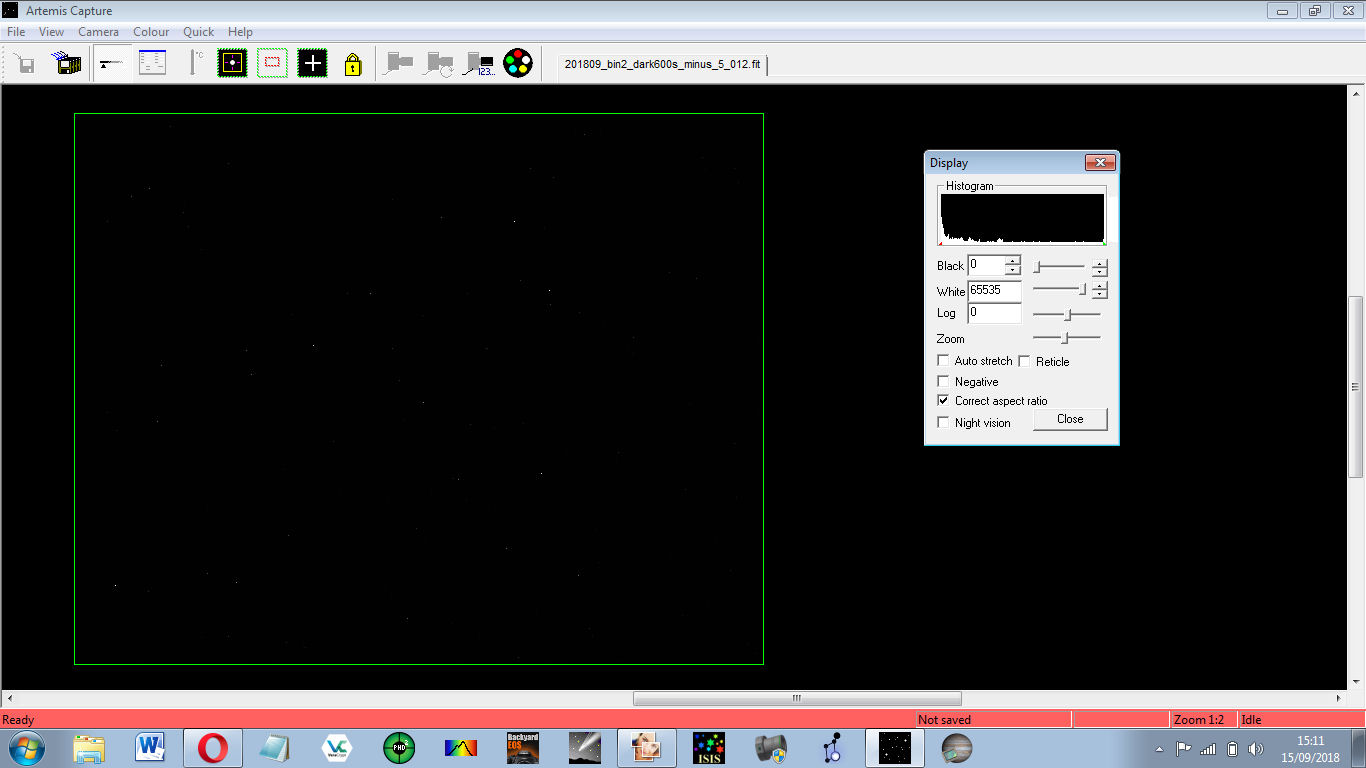› Forums › Spectroscopy › New Atik 460, does it have too many hot pixels?
- This topic has 5 replies, 3 voices, and was last updated 7 years, 3 months ago by
 John Coffin.
John Coffin.
-
AuthorPosts
-
15 September 2018 at 3:39 pm #574126
 John CoffinParticipant
John CoffinParticipantI’ve just bought a new Atik 460 Ex, monochrome version to use with my Alpy 600. I’ve never had a CCD before so don’t know what is normal. Can anyone advise me if this number of hot pixels is normal for this camera, or should I ask for a replacement.
Here is a view in Artemis of a 600 second dark frame at -5 C binned x 2. It has been autostretched.
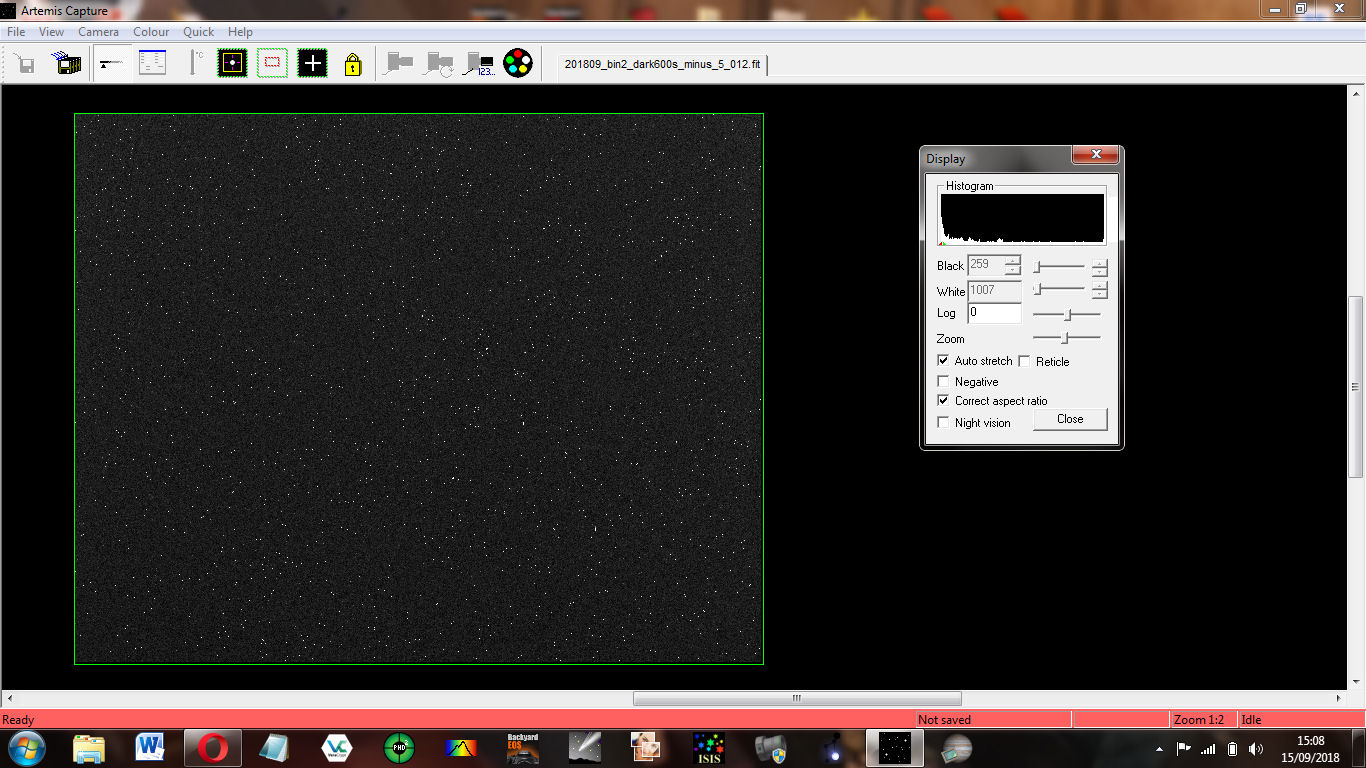
This is an unstretched version of the same dark frame.

I’ve tried to upload the fit file here but is is over 2 mb and isn’t accepted. Is there any other way of making it available?
The jpg versions of the above screen shots are attached to this post.
Hopefully I’m worrying for nothing, but don’t want to have paid all that money for a bad chip. Thanks in anticipation.
John
Attachments:
15 September 2018 at 4:35 pm #579995 Robin LeadbeaterParticipant
Robin LeadbeaterParticipantHi John,
I remember there was some discussion on the ARAS forum about the long tail of warm pixels seen in cameras with Sony CCD which seems to have got progressively worse with each generation.
http://www.spectro-aras.com/forum/viewtopic.php?f=8&t=1919&p=9871
I recently saw an article somewhere which suggested this was a characteristic of CCD with anti-blooming, a connection had not been aware of before.
Discounting these, the noise figure of these CCD is very good though and they seem to respond well to dark subtraction.
Running at a lower temperature might help. I run my similar ATK428 at -10C all the year round.
Robin
16 September 2018 at 8:24 am #579996 Andy WilsonKeymaster
Andy WilsonKeymasterHi John,
I have a 5 year old Starlight Xpress SXVR-H694. This uses the same chip as your Atik 460 Ex and I still have my dark frames from when it was new. Here are a few screenshots for comparison, noting these are 2×2 and 300 seconds, so half the exposure time of your dark frames. Also I always run my camera at -15C or -20C, and these were taken at -15C. You will still get good results at warmer temperatures, but I do all I can to mitigate thermal/dark noise. You can do a test to see how cold you camera can go, but always set the target temperature a few degrees above that so the temperature can easily be held constant.
As you have found, how you set the screen stretch makes a big differences as to how the dark frame looks. If you stretch the image enough then you will always see hot pixels, though when they are only slightly above the normal level it is better to think of them in terms of warm pixels. These warm pixels should not degrade your observations by much when you use dark frames to correct for them.
My first screenshot is of a medium screen stretch in MaximDL. This is an aggressive linear stretch with black at 1001.8 and white at 1223.9, so this really emphasizes the warm pixels. These pixels will have a minimal affect of the data quality as long as they are corrected by a dark frame.

I now switch to a linear stretch for the range of the camera with black at 0 and white at 65536. Now none of the warm pixels show up, but there are at least 4 hot pixels.
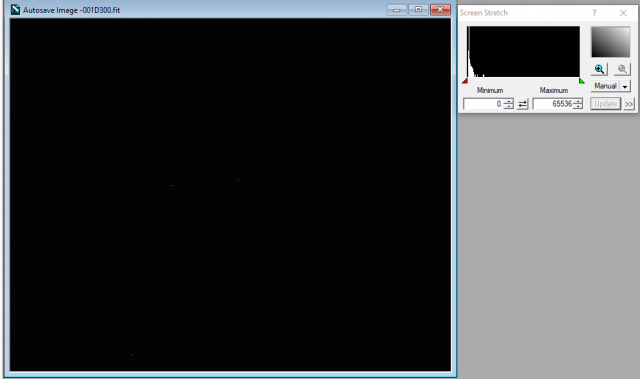
Finally, it is informative to look at a histogram of the CCD. Note the number of pixels is on a log scale, vertically up, with the intensity along the x-axis. So there are a handful of hot pixels above 10000 while a reasonable number from about 2000 to 10000. These warmer pixels will loose some dynamic range but after dark subtraction will still hold useful photon counts.
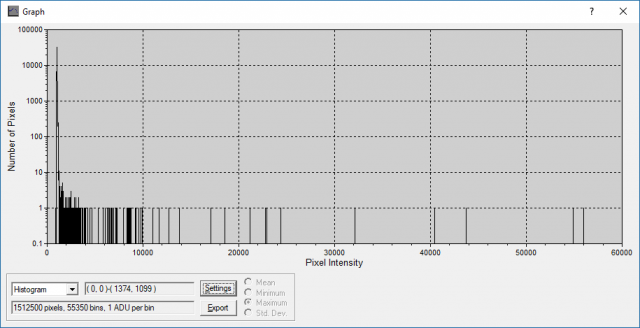
Cheers,
Andy
16 September 2018 at 12:31 pm #579998 Robin LeadbeaterParticipant
Robin LeadbeaterParticipantHi John,
Here is a link to a dark taken under the same conditions as yours using my ATIK 428. This camera is identical except for using a smaller version of the same CCD so should be a direct comparison.
https://drive.google.com/file/d/1QkocrvkQRBCOlTK9NbxOhSVxWMwM7COg/view?usp=sharing
If you have ISIS, it includes a nice feature which you can use to calculate the gain, and noise figures described here
http://www.astrosurf.com/buil/isis/noise/result.htm
These warm pixels are not specifically measured using this technique though. To get the dark current figures quoted by ATIK and measured by Christian Buil, you have to chose a measured area free of warm pixels.
Robin
16 September 2018 at 3:55 pm #579999 Robin LeadbeaterParticipant
Robin LeadbeaterParticipantLooking in detail at the distribution of these warm pixels in my camera it seems most of them fall between 500-800 ADU, causing the “knee” in the cumulative distribution described in the ARAS thread. They are in fixed positions and only represent ~1 in every 2000 pixels though and are low enough to be corrected by a dark provided they are otherwise well behaved.
Robin
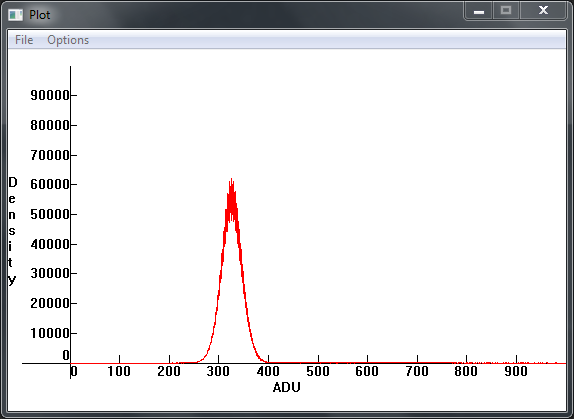
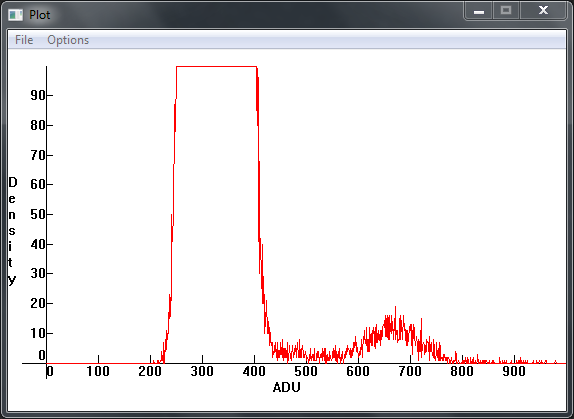 16 September 2018 at 9:39 pm #580002
16 September 2018 at 9:39 pm #580002 John CoffinParticipant
John CoffinParticipantThank you both for your very helpful comments and for the trouble you have taken to produce your data. I will experiment to see how much I can cool the camera. I didn’t realise that ‘warm pixels‘ can still collect useful information and that is reassuring.
-
AuthorPosts
- You must be logged in to reply to this topic.

